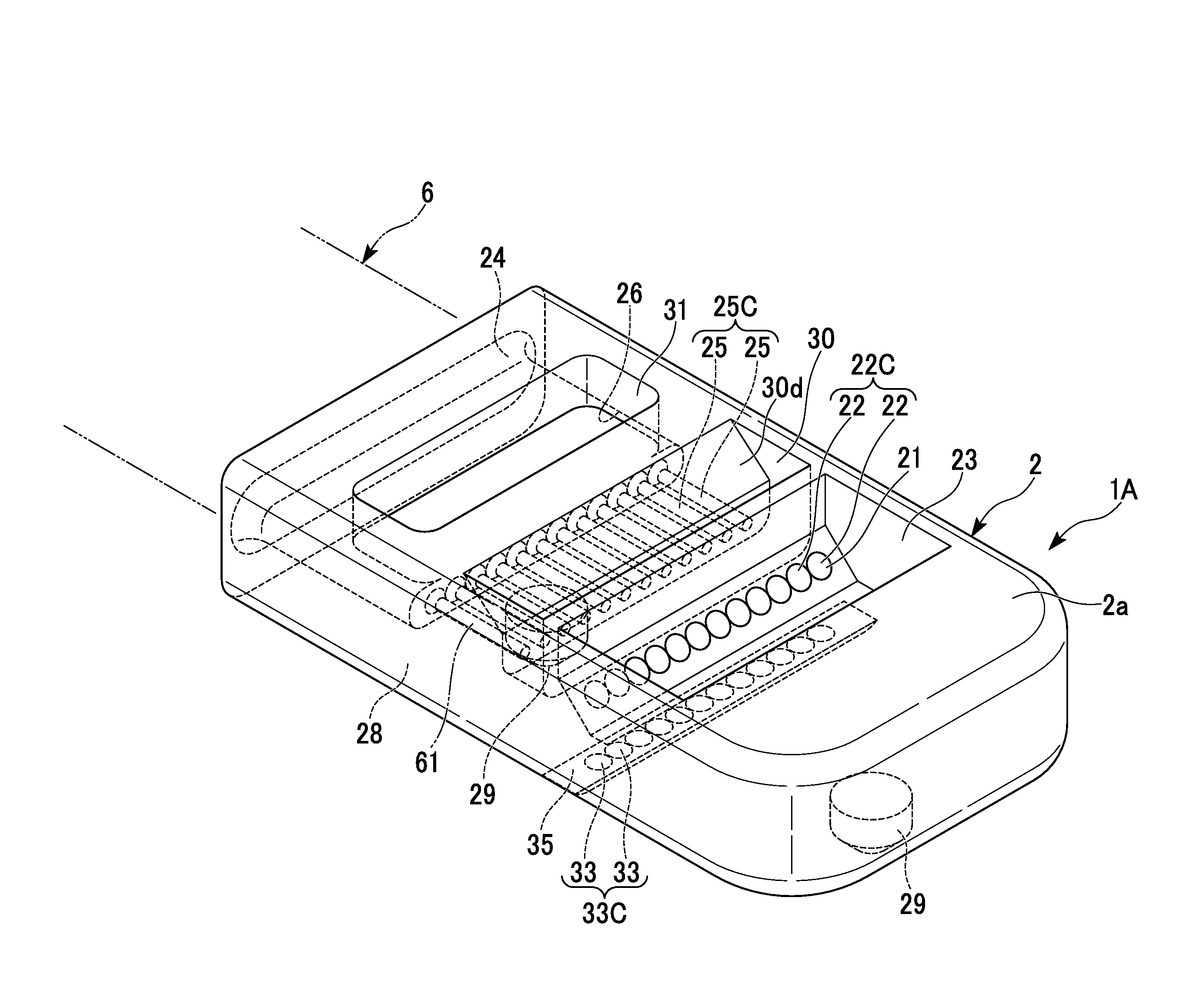Optical path-changing member
a technology of optical path and optical path, applied in the field of optical path change member, can solve the problem of difficult to change the optical path of incident light to the optimum direction, and achieve the effect of high-precision optical path chang
- Summary
- Abstract
- Description
- Claims
- Application Information
AI Technical Summary
Benefits of technology
Problems solved by technology
Method used
Image
Examples
first embodiment
[0029]Hereinafter, a first embodiment of the present invention will be described in detail based on the drawings.
[0030]FIG. 1 is a perspective view of an optical path-changing member 1A of the first embodiment related to the present invention. FIG. 2 is a cross-sectional view of the optical path-changing member 1A. FIG. 3 is an enlarged cross-sectional view of the optical path-changing member 1A.
[0031]In the following description, a leading end direction (the right direction in FIG. 2) of a multi-core optical fiber 6 is sometimes referred to as the front and the opposite direction (the left direction in FIG. 2) thereto is sometimes referred to as the rear. Further, the front-back direction is a direction of an optical axis of the multi-core optical fiber 6.
[0032]As shown in FIGS. 1 and 2, a member main body 2 constituting the optical path-changing member 1A is provided at a terminal of the multi-core optical fiber 6, and the member main body 2 is installed to face an optical module ...
second embodiment
[0088]FIG. 4 is a perspective view of an optical path-changing member 113 of a second embodiment related to the present invention. FIG. 5 is a cross-sectional view of the optical path-changing member 1B. FIG. 6 is an enlarged cross-sectional view of the optical path-changing member 113.
[0089]As shown in FIGS. 4 and 5, optical fiber insertion holes 25 (25a and 25b) and first lenses 22 (22a and 22b) of the optical path-changing member 1B are two-dimensionally arranged so as to form a plurality of stages.
[0090]The optical fiber insertion holes 25 (25a and 25b) form a plurality of stages 25A and 25B (optical fiber insertion hole rows) that are made by arranging a plurality of optical fiber insertion holes 25 side by side in a lateral direction, and the first lenses 22 (22a and 22b) form a plurality of stages 22A and 22B that are made by arranging a plurality of first lenses 22 side by side in a lateral direction.
[0091]The optical fiber insertion holes 25 and the first lenses 22 are arra...
third embodiment
[0108]FIG. 7 is a perspective view of an optical path-changing member 1C of a third embodiment related to the present invention. FIG. 8 is a cross-sectional view of the optical path-changing member 1C.
[0109]As shown in FIGS. 7 and 8, optical fiber insertion holes 125 (125a and 125b) and first lenses 122 (122a and 122b) are two-dimensionally arranged so as to form a plurality of stages. The first lenses 122 (122a and 122b) form a plurality of stages 122A and 122B that are made by arranging a plurality of first lenses 122 side by side in a lateral direction.
[0110]The optical fiber insertion holes 125 and the first lenses 122 are arranged in two stages to correspond to the multi-core optical fibers 6 having a two-stage configuration.
[0111]When viewed from the direction of the optical axis of the light, positions of the optical fiber insertion holes 125 correspond to positions of the first lenses 122. Here, therefore, the embodiment will be described with reference to the positions of t...
PUM
 Login to View More
Login to View More Abstract
Description
Claims
Application Information
 Login to View More
Login to View More - R&D
- Intellectual Property
- Life Sciences
- Materials
- Tech Scout
- Unparalleled Data Quality
- Higher Quality Content
- 60% Fewer Hallucinations
Browse by: Latest US Patents, China's latest patents, Technical Efficacy Thesaurus, Application Domain, Technology Topic, Popular Technical Reports.
© 2025 PatSnap. All rights reserved.Legal|Privacy policy|Modern Slavery Act Transparency Statement|Sitemap|About US| Contact US: help@patsnap.com



